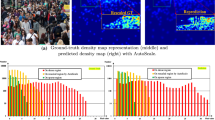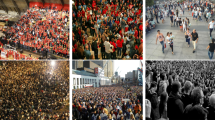Abstract
Ensuring the trustworthiness of artificial intelligence and machine learning systems is becoming a crucial requirement given their widespread applications, including crowd counting, which we focus on in this work. This is often addressed by integrating uncertainty measures into their predictions. Most Bayesian uncertainty quantification techniques use a Gaussian approximation of the output, whose variance is interpreted as the uncertainty measure. However, in the case of neural network models for crowd counting based on density estimation, where the ReLU activation function is used for the output units, such a prior may lead to an approximated distribution with a significant mass on negative values, although they cannot be produced by the ReLU activation. Interestingly, we found that this is related to “false positive” pedestrian localisation errors in the density map. We propose to address this issue by shifting the Bayesian Inference Before the reLU EStimates (BLUES). This modification allows us to estimate a probability distribution both on the people density and the people presence in each pixel. This allows us to compute a crowd segmentation map, which we exploit for filtering out false positive localisations. Results on several benchmark data sets provide evidence that our BLUES approach allows for improving the accuracy of the estimated density map and the quality of the corresponding uncertainty measure.
Access this chapter
Tax calculation will be finalised at checkout
Purchases are for personal use only
Similar content being viewed by others
Notes
- 1.
Some authors do not consider ensemble methods to follow a Bayesian approach. For a discussion, we refer the reader to https://cims.nyu.edu/~andrewgw/deepensembles/.
References
Abdar, M., et al.: A review of uncertainty quantification in deep learning: techniques, applications and challenges. Inf. Fusion 76, 243–297 (2021). https://doi.org/10.1016/j.inffus.2021.05.008
Beauchamp, M.: On numerical computation for the distribution of the convolution of N independent rectified Gaussian variables. J. Soc. Fr. Stat. 159(1), 88–111 (2018)
Chan, A.B., Liang, Z.S.J., Vasconcelos, N.: Privacy preserving crowd monitoring: counting people without people models or tracking. In: CVPR, pp. 1–7 (2008). https://doi.org/10.1109/CVPR.2008.4587569
Chen, K., Loy, C.C., Gong, S., Xiang, T.: Feature mining for localised crowd counting. In: BMVC, pp. 1–11 (2012). https://doi.org/10.5244/C.26.21
Chen, Y., Yang, J., Chen, B., Du, S.: Counting varying density crowds through density guided adaptive selection CNN and transformer estimation. IEEE Trans. Circuits Syst. Video Technol. 33(3), 1055–1068 (2023). https://doi.org/10.1109/TCSVT.2022.3208714
Delussu, R., Putzu, L., Fumera, G.: Investigating synthetic data sets for crowd counting in cross-scene scenarios. In: VISIGRAPP, pp. 365–372 (2020). https://doi.org/10.5220/0008981803650372
Ferryman, J., Shahrokni, A.: PETS2009: dataset and challenge. In: 2009 Twelfth IEEE International Workshop on Performance Evaluation of Tracking and Surveillance, pp. 1–6 (2009). https://doi.org/10.1109/PETS-WINTER.2009.5399556
Gal, Y., Ghahramani, Z.: Dropout as a bayesian approximation: representing model uncertainty in deep learning. In: ICML. JMLR Workshop and Conference Proceedings, vol. 48, pp. 1050–1059 (2016)
Guerrero-Gómez-Olmedo, R., Torre-Jiménez, B., López-Sastre, R.J., Maldonado-Bascón, S., Oñoro-Rubio, D.: Extremely overlapping vehicle counting. In: IbPRIA. Lecture Notes in Computer Science, vol. 9117, pp. 423–431 (2015). https://doi.org/10.1007/978-3-319-19390-8_48
Hüllermeier, E., Waegeman, W.: Aleatoric and epistemic uncertainty in machine learning: an introduction to concepts and methods. Mach. Learn. 110(3), 457–506 (2021). https://doi.org/10.1007/s10994-021-05946-3
Kendall, A., Gal, Y.: What uncertainties do we need in bayesian deep learning for computer vision? In: Guyon, I., etal (eds.) Advances in Neural Information Processing Systems, vol. 30, pp. 5574–5584 (2017)
Khan, M.A., Menouar, H., Hamila, R.: Revisiting crowd counting: state-of-the-art, trends, and future perspectives. Image Vis. Comput. 129, 104597 (2023). https://doi.org/10.1016/j.imavis.2022.104597
Lakshminarayanan, B., Pritzel, A., Blundell, C.: Simple and scalable predictive uncertainty estimation using deep ensembles. In: Advances in Neural Information Processing Systems, vol. 30, pp. 6402–6413 (2017)
Ledda, E., Fumera, G., Roli, F.: Dropout injection at test time for post hoc uncertainty quantification in neural networks. CoRR abs/2302.02924 (2023). https://doi.org/10.48550/arXiv.2302.02924
Ma, Z., Wei, X., Hong, X., Gong, Y.: Bayesian loss for crowd count estimation with point supervision. In: ICCV, pp. 6141–6150 (2019). https://doi.org/10.1109/ICCV.2019.00624
MacKay, D.J.C.: A practical bayesian framework for backpropagation networks. Neural Comput. 4(3), 448–472 (1992). https://doi.org/10.1162/neco.1992.4.3.448
Minaee, S., Boykov, Y., Porikli, F., Plaza, A., Kehtarnavaz, N., Terzopoulos, D.: Image segmentation using deep learning: a survey. IEEE Trans. Pattern Anal. Mach. Intell. 44(7), 3523–3542 (2022). https://doi.org/10.1109/TPAMI.2021.3059968
Modolo, D., Shuai, B., Varior, R.R., Tighe, J.: Understanding the impact of mistakes on background regions in crowd counting. In: WACV, pp. 1649–1658 (2021). https://doi.org/10.1109/WACV48630.2021.00169
Oh, M.H., Olsen, P., Ramamurthy, K.N.: Crowd counting with decomposed uncertainty. In: AAAI, pp. 11799–11806 (2020). https://doi.org/10.1609/aaai.v34i07.6852
Socci, N., Lee, D., Seung, H.S.: The rectified gaussian distribution. In: Advances in Neural Information Processing Systems, vol. 10. MIT Press (1997)
Wang, X., Zhan, Y., Zhao, Y., Yang, T., Ruan, Q.: Semi-supervised crowd counting with spatial temporal consistency and pseudo-label filter. IEEE Trans. Circuits Syst. Video Technol. 33, 1–1 (2023). https://doi.org/10.1109/TCSVT.2023.3241175
Yuan, L., Chen, Y., Wu, H., Wan, W., Chen, P.: Crowd counting via localization guided transformer. Comput. Electr. Eng. 104(Part), 108430 (2022). https://doi.org/10.1016/j.compeleceng.2022.108430
Zhai, W., Gao, M., Li, Q., Jeon, G., Anisetti, M.: FPANet: feature pyramid attention network for crowd counting. Appl. Intell., 1–18 (2023). https://doi.org/10.1007/s10489-023-04499-3
Zhang, X., et al.: A multi-scale feature fusion network with cascaded supervision for cross-scene crowd counting. IEEE Trans. Instrum. Meas. 72, 1–15 (2023). https://doi.org/10.1109/TIM.2023.3246534
Zhang, Y., Zhou, D., Chen, S., Gao, S., Ma, Y.: Single-image crowd counting via multi-column convolutional neural network. In: CVPR, pp. 589–597 (2016). https://doi.org/10.1109/CVPR.2016.70
Acknowledgements
Supported by the projects: “Law Enforcement agencies human factor methods and Toolkit for the Security and protection of CROWDs in mass gatherings” (LETSCROWD), EU Horizon 2020 programme, grant agreement No. 740466; “IMaging MAnagement Guidelines and Informatics Network for law enforcement Agencies” (IMMAGINA), European Space Agency, ARTES Integrated Applications Promotion Programme, contract No. 4000133110/20/NL/AF; “Science and engineering Of Security of Artificial Intelligence” (S.O.S. AI) included in the Spoke 3 - Attacks and Defences of the Research and Innovation Program PE00000014, “SEcurity and RIghts in the CyberSpace (SERICS)”, under the National Recovery and Resilience Plan, Mission 4 “Education and Research” - Component 2 “From Research to Enterprise” - Investment 1.3, funded by the European Union - NextGenerationEU.
Emanuele Ledda is affiliated with the Italian National PhD in Artificial Intelligence, Sapienza University of Rome. He also acknowledges the cooperation with and support from the Pattern Recognition and Applications Lab of the University of Cagliari.
Author information
Authors and Affiliations
Corresponding author
Editor information
Editors and Affiliations
Rights and permissions
Copyright information
© 2023 The Author(s), under exclusive license to Springer Nature Switzerland AG
About this paper
Cite this paper
Ledda, E., Delussu, R., Putzu, L., Fumera, G., Roli, F. (2023). BLUES: Before-reLU-EStimates Bayesian Inference for Crowd Counting. In: Foresti, G.L., Fusiello, A., Hancock, E. (eds) Image Analysis and Processing – ICIAP 2023. ICIAP 2023. Lecture Notes in Computer Science, vol 14234. Springer, Cham. https://doi.org/10.1007/978-3-031-43153-1_26
Download citation
DOI: https://doi.org/10.1007/978-3-031-43153-1_26
Published:
Publisher Name: Springer, Cham
Print ISBN: 978-3-031-43152-4
Online ISBN: 978-3-031-43153-1
eBook Packages: Computer ScienceComputer Science (R0)




